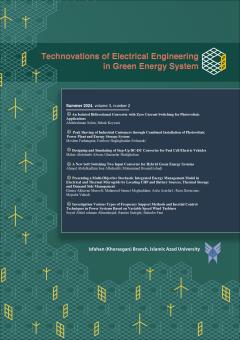برنامهریزی توسعه ایستگاههای شارژ سریع با در نظر گرفتن گسترش چند مرحلهای شبکه توزیع شهری توسط روش برنامهریزی خطی
الموضوعات : Power Engineering
موید محسنی
1
![]() ,
عطیه گل محمدی
2
,
محمد امین بهرامیان
3
,
عطیه گل محمدی
2
,
محمد امین بهرامیان
3
![]() ,
رضا محمدی نیک
4
,
رضا محمدی نیک
4
![]() ,
وحید دواتگران
5
,
وحید دواتگران
5
![]()
1 - شرکت سهامی برق منطقه¬ای خوزستان، اهواز، ایران
2 - دانشکده فنی و مهندسی، گروه مهندسی برق، دانشگاه آزاد اسلامی، واحد تهران مرکز، تهران، ایران
3 - گروه مهندسی برق، دانشکده فنی و مهندسی، دانشگاه اراک، اراک، ایران
4 - مجتمع دانشگاهی بمجتمع دانشگاهی برق و کامپیوتر، دانشگاه صنعتی مالک اشتر، تهران، ایرانرق و کامپیوتر، دانشگاه صنعتی مالک اشتر، تهران، ایران
5 - گروه مهندسی برق، دانشگاه فنی و حرفه¬ای، تهران، ایران
الکلمات المفتاحية: ایستگاه شارژ سریع, توسعه شبکه, خودروی برقی, شبکه توزیع, منابع تجدیدپذیر,
ملخص المقالة :
در سالهای اخیر گرمایش کره زمین و تغییرات اقلیمی یکی از بحث برانگیزترین و پرچالشترین زمینههای مسائل برای دولتها، شرکتها و کنوانسیونهای بین المللی بوده است. که عامل اصلی این گرمایش ابتدا روند صعودی افزایش جمعیت در چند دهه اخیر و سپس افزایش استفاده از سوختهای فسیلی برای تولید انرژی و حمل و نقل بوده است. لذا، اکثر دولتها در برنامهریزیهای کلان خود الزام به حذف خودروهایی با سوخت فسیلی و جایگزینی آنها با خودروهای برقی را دارند. از این رو، با افزایش استفاده از خودروهای برقی در شهرها، بحث برنامهریزی برای مصرف توان الکتریکی توسط آنها و جانمایی صحیح آنها تعداد و مکان آنها به مسأله مهمی برای بهرهبرداران و طراحان تبدیل شده است. در این مقاله به منظور برنامهریزی توسعه شبکه توزیع در حضور ایستگاههای شارژ خودروی برقی و منابع تولید تجدیدپذیر یک روش حل مبتنی بر برنامهریزی خطی عدد صحیح استفاده شده است. تابع هدف این مسئله سعی بر کاهش هزینههای احداث شبکه، پستها، ایستگاههای شارژ، احداث منابع تجدیدپذیر، بانکهای خازنی و خرید برق از شبکه در چشمانداز بلند مدت دارد. روش پیشنهادی روی یک شبکه 18 شینه در سه سناریو اجرا شده که نتایج نشان میدهد حضور ایستگاههای شارژ خودرو برقی در شبکه تا حدی میتواند سودمند باشد و باعث افزایش قابلیت اطمینان و کاهش هزینههای شبکه گردد.


